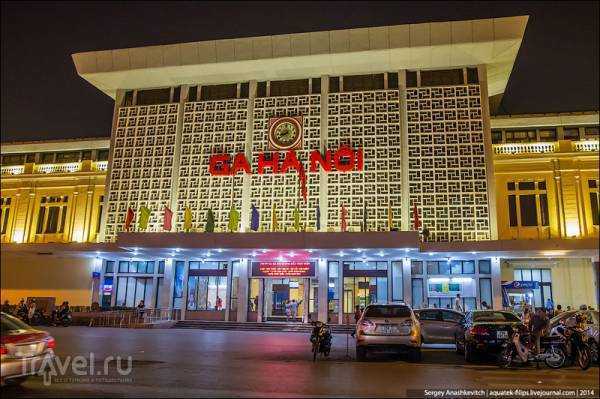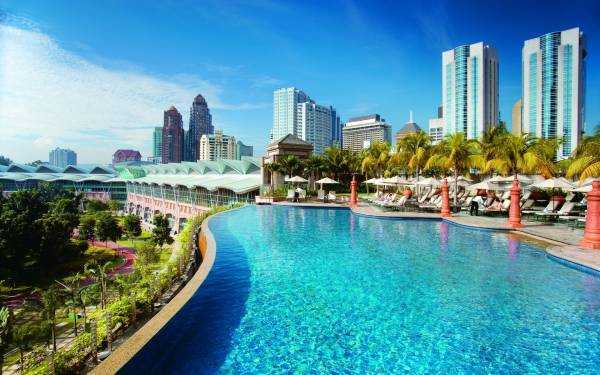What can you expect from a train ride in a Southeast Asian country?
How many people fit into one compartment? Are there any toilets at all? Do you have to sleep standing up or sitting down, clutching your things? A dining car? Is there a dining car? What do they cook in it?
And so, on the very first night after arriving in Vietnam, we went to the central railway station in Hanoi to get answers to these questions - we were about to make the first of many trips around the country - to the very north, to the province of Lao Cai to the Chinese border.
Moving is an integral part of any trip. When moving around the country, you get a lot of new impressions, meet people, see the non-tourist sides of the place you are traveling through and just the ordinary life of this country.
On this trip to Vietnam we will have to travel a lot by all possible means of transport - cycle rickshaws and motorbikes, cars and regular buses, fishing boats and a large ship with 5-star cabins, domestic airlines and trains.
We started with the train on the very first day.
It's twenty to nine in the evening at the central station of Hanoi, which is called Ga Hanoi.
From here our overnight train SP-1 Hanoi-Lao Cai departs, which will take us to the very north of Vietnam.

This is what tickets for our train look like.
I will say right away that SP-1 is the most comfortable type of train (first class) that runs in Vietnam. There is also SP-2 (second class). Tickets are cheaper and the conditions are… simpler, to put it mildly.
The distance from Hanoi to Lao Cai is about 400 kilometers, the train leaves at 21.15 and arrives at the final station at 06.30. Our ticket costs about 40 dollars per person one way and this is very very expensive by local standards and it is impossible to buy tickets at the station. Why? I will explain below.

Walking along the passage to my platform, I saw a scene of conductors loading fresh bed linen into a carriage.
They do it right through the carriage window. Why? Because it's the only possible way. The passage through the carriage and the doors are so narrow that large bundles of sheets and duvet covers simply won't fit through)

And on the roof of the carriage they are already waiting...
Three guys made themselves comfortable on the air conditioning unit of a train car

We are met by a smiling conductor. While I am taking a photo of him, Sasha is trying with difficulty to squeeze through the narrow door of the carriage. Seriously, with a backpack on his shoulder, he pushed through it with a slight acceleration)

Passage in a compartment carriage.
To say that it is narrow is to say nothing. There is no way for two people to pass each other, and you have to push your luggage in front of you on the way to your compartment. If your suitcase is not very big… A big one simply won’t fit.

And this is our compartment. In terms of class, it is analogous to a sleeping car in our trains.
Just four bunks, wood paneling inside, curtains on the windows, clean made beds, air conditioning, electrical outlets and a bottle of water for each passenger. These are the conditions of the luxury carriage on Vietnam's SP-1 train.
I have already said that it is impossible to buy tickets for this carriage at a regular station ticket office. Why? Because these carriages of increased comfort do not belong to the railway, they are private and tickets for them are sold only at special booking offices. And they cost as much as 40 dollars!
How are they different from the regular first class train carriages? Let's go and see.

We move to a regular carriage.
The completely different finish is immediately noticeable - instead of wooden panels there is ordinary plastic.
The passage is just as narrow, stimulating a sporty lifestyle.

And this is a regular Vietnamese compartment on a first class train.
And if, unlike our SV, the Vietnamese SV has not two, but four sleeping places, then the compartment has six on three shelves.
As they say, travel in comfort on VZhD trains)
Our train consisted only of compartment cars, but of different classes - 4-berth and 6-berth.
Compartment carriages are used in SP-2 trains.

Toilet on a first class Vietnamese train.
No water on the floor or blackness on the walls, as is often the case in our compartment cars.

And this is the toilet in a carriage with 6-berth compartments.
There's just a hole in the floor here. Everyone understands that luck is important here, so that there isn't a passenger with stomach problems in the carriage...

Washbasin. It is not located in the toilet compartment, but opposite it in the corridor, so if you want to wash in the morning, you do not have to wait for someone to sort out their indigestion first.

In a compartment carriage with three shelves there is a washbasin for two cups, since there are more people in the carriage.
There is a boiler with cold and boiling water nearby.
Our antediluvian boilers opposite the conductor’s compartment immediately come to mind.
Do you see the plastic chair again? It was there in photo 7 too.
This is the conductor's place.
Yes, yes, not two compartments like we have - a service compartment with two sleeping places and a compartment where the conductor sits at normal times, but just a chair. The Vietnamese conductor does not have a separate compartment, in which you can still manage to sell a place.

Although the conductor needs to sleep, and he does have a place for it, as this sign eloquently states.
But the sleeping area is a very narrow niche at floor level, which is located under the cabinets with the car's electrical equipment.

In the 13th carriage there is not one fire extinguisher, but two.
Vietnamese people are very superstitious

The train conductor inspects the carriages.
The conductors hardly ever sit on their chairs.
In their free time, they constantly mop the floor in the train car and the toilet…

Just like on our trains, there are beer and water vendors walking around the carriages.
They immediately announce a high price, but if you bargain well, they will give it to you at a discount)

The beer is bought and Sasha Kosenko talks about local trains…

I couldn't resist the pleasure of visiting the Vietnamese dining car.
Two hours after the train's departure, there are not many people here and all the visitors are foreigners.
In general, it must be said that the majority of the train passengers were foreigners who were traveling to Sapa, an incredibly beautiful place, and could easily afford a ticket for 30-40 dollars.

And here are the conductors, whiling away the time on their smartphones.
They don't want to sit in their carriages, because they'd have to pick up a mop right away, so they hang out in the dining car.

Sasha trolls the local chef by telling him that his belly is too small for a chef.
The Vietnamese disagrees and says that he has a good stomach and that he feeds well in the dining car.

Let's go to his kitchen...
There is only one dish on the menu - noodle soup with spinach.
The cook puts water on the fire, throws spinach in and looks for noodles on the shelf….

Five minutes, the noodle and spinach soup is ready.
I must say, very tasty!
Overall, the first visit to the dining car was not a failure)

Vietnamese people are crazy about taking pictures, especially with Europeans.
Taking a souvenir selfie with Vietnamese guides

Six in the morning, Laocai.
It's quite cool here and it rains from time to time.
Well, this is Vietnam, it's normal here

And opposite our train stands SP-2.
It is, of course, noticeably different.
Glass? Nooo, glass on windows is expensive!
The fine mesh is just right. Perhaps we will have another chance to ride here, right among the crowds of Vietnamese…

Lao Cai Central Railway Station is very different from Hanoi's…
This is the very north of Vietnam. From here we still have about an hour to go to Sa Pa, where we will spend the next two days…

Source: travel.ru













